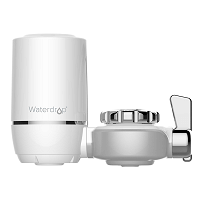Managing personal health is one of the most popular pursuits of mankind, especially in terms of extending overall longevity. Food and water sources are under constant scrutiny, especially in regard to which method is superior to another, and the debate over filtered tap water vs bottled water is no exception. So which type of drinking water is safest, and deserving of a spot in your household?
Filtered Tap Water
Water filters are capable of purifying tap water by allowing water to flow through various types of filter media utilizing different methods. The type of media utilized is completely dependent upon the manufacturer, model, and, in some cases, consumer discretion. Ultimately, the goal is to obtain safe drinking water for your household, without the need for excessive plastic or dangerous chemicals.
Charcoal Filtration
Filters may utilize cartridges containing activated charcoal. Charcoal has an inherent characteristic of high porosity, which makes it capable of bonding to various contaminants commonly found in tap water. While this may take care of numerous impurities, the fact of the matter is that it mostly captures chlorine. Activated charcoal isn’t capable of bonding to all materials, which means many contaminants pass through activated charcoal unscathed. Additionally, charcoal requires frequent cartridge replacements in order to maintain a high standard of filtration. Otherwise, the pores quickly become clogged, incapable of bonding with subsequent contaminants and chemicals.
Waterdrop WD-FC-01 Faucet Water Filter
By adopting selected and thoroughly tested Activated Carbon Black (or ACF), Waterdrop water filter cartridges feature a large surface area, with a collection of microholes. These holes effectively absorb present substances that may be harmful to your health, producing safe, pure drinking water. Waterdrop’s filter system provides up to 3 months of use, or 320 gallons of clean water. This makes it one of the most cost-effective water filter options on the market. Homeowners would only need four replacements for an entire year of dependable filtration.
AO Smith Whole House Carbon Filtration System
For clean water you can taste, the AO-WH-FILTER reduces up to 97% of all Chlorine commonly present in tap water. A whole house filter provides the convenience of filtering tap before it flows through to you faucets, for whole house peace of mind. Overall, this system will reduce your family’s exposure to chlorine, as well as a plethora of other chemicals that lead to health problems in the water and air. Covered by a 6 year limited warranty, the AO-WH-Filter provides 6 years of water filtration, or 600,000 gallons of water. Everything you need to get started is included in the package, such as a hose adapter, shut-off valve, and more. Some other tools may be required for a complete installation but, otherwise, you won’t need to call a plumber to complete the task.
Reverse Osmosis
Reverse Osmosis purification systems create safe drinking water by separating clean water from impure water. Under high pressure, the tap water is forced through a porous membrane, in order to remove impurities. Nearly 100% of all harmful bacteria, dissolved solids, and organic material is removed through this method, with very little energy consumption. This does mean, however, longer processing times, in order to ensure completely pure water. Additionally, RO systems may be more involved and expensive to maintain. Some companies do offer subscription services, in order to ensure monthly maintenance is kept up on with high quality service.
iSpring 6-Stage Reverse Osmosis Water Filter
For optimal protection, you can’t go wrong with a multi-layered filter system, like the RCC7P-AK from iSpring. This pressure-boosted system enables the removal of 1000 types of contaminants, while also improving the performance of water pressure. Tap water is forced through various stages of filtration, at a high rate of speed, in order to reduce overall waste water, and improve filtration results. This makes an ideal solution for homes with low pressure, such as 40 PSI or less, where other filtration options fall flat. Put your household in good hands, by utilizing an RO system from iSpring, and enjoy the confidence that this system provides.
Waterdrop D4 RO Drinking Water Filtration System
The Waterdrop RO Drinking Water Filtration System, aside from offering premier RO filtration, features a tankless design. Measuring in at 12.44” tall, Waterdrop’s tankless RO system puts an elegant spin on a household necessity. When you need the guarantee of a high output, with a small footprint, the Waterdrop D4 RO will not let you down. Simply install the system underneath most kitchen sinks, or any other kitchen cabinet with space, and enjoy.
By adopting an innovative technology and design, Waterdrop has integrated various filtration materials to produce a 5-in-1 filter. This filter demands less space, while achieving optimal filtration capabilities, in order to reduce: chlorine, TDS, heavy metals, pesticides, and more. You will appreciate the automatic flush after 1 hour of zero operation, which ensures the filter remains pure at all times. This also supports the filter’s lifespan, providing consumers with the highest quality effect in water filtration.
Pros of Filtered Drinking Water
There are large variety of reasons to opt for filtered water over bottled water. Aside from lessening the demand for plastic, home water filtration takes the guess work out of toting cases of bottled water into your home. Aside from that, here are a few additional reasons why you should make the switch from bottled to filtered water.
Odor-Free Water
If you have ever noticed a funny smell coming from your faucet, it’s most likely derived from chlorine used to treat tap water. Local municipal water sources routinely add chlorine in order to kill off any bacteria that may be present in city water. The most basic of water filters are capable of removing chlorine from local water. This means, even if you invest in the cheapest faucet water filter, chances are, you will eliminate funny odors – activated charcoal is great at absorbing odors.
Filtered Water is Healthy
Water filtration removes certain chemical and physical particles that pose a danger to human health when consumed. This includes herbicides and pesticides used in industrial farming, which leech into water systems through runoff. Reverse Osmosis, for example, is a great process by which many of these dangerous contaminants may be removed. However, it is important to note that natural water does contain essential minerals required for good health, which may be removed by an RO system.. This further highlights the importance of utilizing a means of remineralization, when utilizing a Reverse Osmosis water purification system.
Filtered Water Fits into a Budget
The initial cost for your average filtration system may seem steep up front, but it will quickly turn into a money-saving investment with some use.
The Downside to Filtered Water
As with everything, there are pros and cons to consider. With filtered water, the cons mostly incorporate cost, and not quality of water output. Here are a few downsides of filtered water to consider:
High Initial Costs
As mentioned, the initial costs associated with a water filtration system can be high. However, the cost is usually offset with some use. If cost is your biggest concern, you are likely to discover other options on the market that better suit your needs, such as renting a machine. This way, you won’t need to invest thousands of dollars on your own system, especially if it’s outside of your budget. Osmosys also offers a subscription service, which ensures proper maintenance on a regular schedule, as well as free installation.
Replace Filters
After the filtration system has been purchased, the only cost to consider is the replacement of water filters. These filter cartridges will require regular replacement, so many times per year (according to the manufacturer). This can vary widely, with many filters providing months of use, if not an entire year, before a replacement is required. Even with these purchases factored in, they are still much less than a year’s worth of bottled water purchases.
Pros of Drinking Bottled Water
Let’s not forget about bottled water, though. What are some of the pros associated with utilizing bottled water over filtered.
Overall Convenience
Ask a group of people, and most would agree: bottled water is convenient. Not only does it allow you to bring water with you, but it provides it’s own carrying case. Simply grab a bottle to enjoy on your trek and be on your way. In the event you forget one at home, simply swing by a convenience store, and grab one from there.
Safe Alternative to Tap
The majority of people worry about the quality of their tap water. When tap water presents a certain danger, bottled water is certainly a safer choice for human consumption, especially since it’s typically comprised of filtered tap water. In most cases, the contaminants and dangerous chemicals have been removed from the tap before filling the bottles.
The Down Side of Drinking Bottled Water
Unfortunately, you may notice that the cons of bottle water quickly begin to outweigh the benefits of bottled water’s taste and convenience. It has become such a problem, in fact, that the EU is beginning to ban the use and production of bottled water entirely. Why would organizations launch a fight against bottled water on a global scale?
Negative Impacts on the Environment
Plastic happens to be one of the top environmental hazards in the world, regardless of it being recyclable. Unfortunately, even though bottled water is used everywhere, up to 80% of all bottles aren’t properly recycled or reused. Up to one million water bottles are purchased every minute around the globe, with numbers steadily increasing. Most of these bottles end up in landfills, where it will take up to 700 years to even begin decomposition. All of this plastic will also come back to bite us in the form of microplastics. Essentially, bottled water drinkers have the potential to consume the equivalent of a credit card’s worth of microplastics twice a month. We must also consider the carbon footprint of production, as well as water transport from bottling plants, as well as grocery stores, gas stations, and more.
What Does it Really Cost
After we have discussed filtered water and bottled water at length, it’s time for you to have your own say. Regardless of how you feel about the environmental and ethical impacts bottled water has on the plant, this final detail should make you sit up straight and think. On average, a 3 person household in the United States invests nearly $600 on bottled water on an annual basis.
What’s the Bottom Line?
With so many types of filtration system available at our fingertips, homeowners are left with many decisions. They can choose between faucet filtration, to under the sink models, or even filtered water beginning from the home’s point of entry. Whether you are looking to add filtered water, or are searching for a household replacement, there is a wide range of information available across our website.

